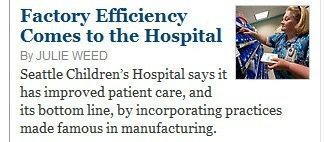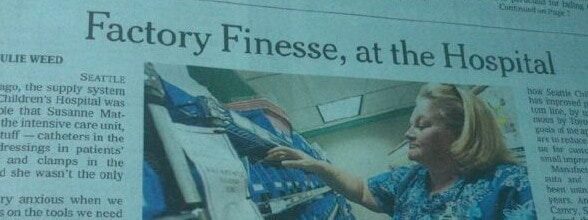
Today's edition of The New York Times has an outstanding article about Lean Healthcare and what Seattle Children's Hospital calls C.P.I. or Continuous Performance Improvement.
The article is titled
“Factory Efficiency Comes to the Hospital“
I wish the headline had also addressed quality, waiting time, and staff engagement, but the article body does, at least. The article highlights Seattle Children's Hospital, as well as others, including members of the Healthcare Value Network (Park Nicollet, Akron Children's, and Paul Levy‘s Beth Israel Deaconess Medical Center), as well as Virginia Mason Medical Center. Yours truly is quoted in the article, as well.
Hear Mark read the post (subscribe to the podcast):
I try not to judge an article by its cover headline. The online headline is a bit cringe-worthy, as it makes you wonder how people from outside manufacturing will read this (the general readership of the Times). It might sound like a negative thing – “What? You're turning the hospital into an assembly line? Oh no!”
In an interesting twist, the print edition headline is different, it reads:
“Factory Finesse, at the Hospital”

I like that headline better. What headline would you have given it, to more fully represent the breadth of improvements that come from Lean healthcare? Leave a comment at the end of the post.
The article highlights the role of Toyota and Lean in their C.P.I. program and there's actually a pretty good definition of Lean for being a mainstream media piece:
The main goals of the approach, known as kaizen, are to reduce waste and to increase value for customers through continuous small improvements.
I wish that definition had included “respect for people” element of the Toyota approach, but at least the definition covered reducing waste (as opposed to just cost cutting) as well as focusing on value and the customer.
Kaizen, is of course, a major part of the Lean and TPS approach.
Benefits of Lean in Healthcare
The article highlights many benefits of Lean:
Making sure nurses have supplies readily available, so they can spend more time with patients
The article gives a nice basic description of what we'd call a “two-bin kanban system,” a very simple and effective strategy. I had the chance to visit Seattle Children's in August of 2009 and I was very impressed with their supply chain processes and kanban systems (put in place by a VP who came from the high-tech manufacturing world).
Fully engaging staff leads to fewer mistakes, better outcomes, and lower cost
From the article:
And while a sick child isn't a Camry, Seattle Children's Hospital has found that checklists, standardization and nonstop brainstorming with front-line staff and customers can pay off.
“It turns out the highest-quality care also is the most cost-effective because we make fewer mistakes and create better outcomes,” says Patrick Hagan, the hospital's president.
Hagan outlined some other improvements in terms of cost and capacity:
- Cost per patient is DOWN 3.7% (think about that for a minute in this environment)
- The hospital is serving 38,000 patients a year, compared to 27,000 in 2004 (a 40% increase) without expanding or adding beds (this has saved them $180 million, they claim)
Thankfully, the article strikes a balance between quality and cost improvements, talking about how they go hand in hand:
“Some people think they have to choose between quality of care and saving money,” said Dr. David Chand, who attended the training and now uses C.P.I. methods at Akron Children's Hospital in Ohio. “C.P.I. improves both patient outcomes and the hospital's bottom line.”
Unfortunately, the article doesn't give really good quantifiable examples of quality improvement, but at least it was discussed.
Creativity over Capital
Akron Children's describes how they reduced waiting time for non-emergent MRIs from 25 days to just 1 or 2 days. Again, this was done without expensive capital spending — a $20,000 improvement project worked for them, allowing them to avoid a $3.5 million dollar construction project. These sorts of savings are being seen at leading Lean hospitals around the country – imagine the impact on our national health bill if we can spread this thinking!
The end of the article also mentions savings related to new construction at a new facility in Bellvue, WA:
The hospital was able to shave 30,000 square feet and $20 million off of the new building, which is to open July 20.
Both Sides of the Story (?)
Responsible journalism covers both sides of the story. Even with the overwhelming praise for Lean and C.P.I. methods in the article, you can always find somebody who doesn't like Lean — or they're willing to say they're opposed to Lean because it serves their purpose, perhaps.
In this case, it's the Minnesota Nurses Association, a group I've been trying to have a constructive debate with, but it's seeming more and more pointless (not surprising considering their misleading video that I blogged about the other day). You try to talk about Lean, and they fall back on complaints about greedy business people and how much money the hospital executives are making.
The union is quoted as saying:
She says that in an effort to reduce waste, consultants observed her and her colleagues and tried to determine the amount of time each of their tasks should take. But procedure times can't always be standardized, she says. For example, some children need to be calmed before IV's are inserted into their arms, or parents may need more information.
Now they may have a point here. Remember that the Toyota Way has two “equally important pillars”:
- Continuous improvement and waste reduction
- “Respect for humanity” (aka respect for people)
When things are done in the name of “lean” that ignore respect for people, we call that “L.A.M.E.” here on the Lean Blog (“Lean as Misguidedly Executed”).
If indeed the consultants were just hovering over the nurses, that's out-dated Taylorist time study, that's not Lean. You can collect time data, but it shouldn't be used as a quota or a mindless target. Lean thinkers realize there is variation in healthcare and that some patients will require more time, that should be built into the process and the staffing model.
So the nurse could be complaining about L.A.M.E. or she's misrepresenting it. Who knows.
The union also complains that Lean has led to “unsafe staffing levels,” but the hospitals disagree, saying:
Brian Lucas, a spokesman for Children's Hospitals and Clinics of Minnesota, says the lean efforts have been used to reduce unnecessary tasks and have not resulted in lower nurse-to-patient ratios. “To the contrary,” he said, “they have allowed nurses to spend more time delivering care to patients.”
I Got Quoted – and Not Horribly Misquoted!
The reporter, Julie Weed, reached out to me on Wednesday, looking for some quotes about the challenges with Lean – if this methodology is so popular and so effective, why isn't everyone doing it?
From the article:
Techniques like C.P.I. may indeed be hard for many hospitals to put into effect, says Mark Graban, a senior fellow at the Lean Enterprise Institute, a nonprofit research, education and publishing company. The process takes a large amount of time and requires a culture shift that many hospitals may not be able to accommodate or sustain. “If the leadership tries to force new ways of doing things, the staff may chafe under the successive changes,” he says.
There's always a risk of being misquoted and I don't think that happened here, thankfully. The reporter got the tone of my comments correct, too I think (I was afraid of seeming like a critic of Lean). Lean works amazing well in healthcare, but it requires a lot of leadership from all levels and it takes time to change mindsets. Lean concepts seem simple, but making this happen ain't easy.
Final Comments
The article has quotes from physicians, talking about how they came to believe in these ‘factory methods.' The article also mentions Joan Wellman, the consultant who started with Seattle Children's and their initial Lean / C.P.I. in the mid-90s. She's such a pioneer and it's great to see her get this much-deserved recognition. You might want to check out my podcast interview with Joan, she's great.
I'm curious to hear your comments about the article! Thanks to the NY Times for highlighting this exciting movement in healthcare improvement.
For those who are new to the blog, you can read more about Lean Healthcare in my book, Lean Hospitals: Improving Quality, Patient Safety, and Employee Satisfaction. The article focused quite a bit on staff-level improvements, but to learn more about how top leaders need to change their leadership styles, read the outstanding book from Dr. John Toussaint (published by LEI): On the Mend: Revolutionizing Healthcare to Save Lives and Transform the Industry.
Please scroll down (or click) to post a comment. Connect with me on LinkedIn.
Let’s work together to build a culture of continuous improvement and psychological safety. If you're a leader looking to create lasting change—not just projects—I help organizations:
- Engage people at all levels in sustainable improvement
- Shift from fear of mistakes to learning from them
- Apply Lean thinking in practical, people-centered ways
Interested in coaching or a keynote talk? Let’s start a conversation.










Mark:
It’s a great piece in the NY Times. Reporter Julie Weed deserves applause for telling the story well. NICE JOB, JULIE WEED!
With regard to the “other side of the story” from the perspective of the Minnesota Nurses Association, I think we just have to keep coming back to the basic lessons of seeing and eliminating waste when we teach or debate. Beautifully laid out in Matt Wrye’s guest post here on June 21, the point is that we don’t need to do damage when we eliminate waste. The safe place to start is not changing someone’s WORK (meaning value added activities) but removing barriers to work. It improves the work environment and it’s where most of the savings are anyway.
It’s a concern everywhere – I led a half-day workshop at an industry association meeting yesterday and the question was raised up front: what if we don’t have a perfect understanding of customer defined value and we do damage in our efforts to eliminate waste? My answer (I invite comments!) was “If we have 80 – 90% waste in our system, we can make such huge progress without going anywhere NEAR value added activities, that we can easily avoid such problems as we set out on this journey.”
The people of the Minnesota Nurses Association are apparently getting a very different message. If I were in their work setting being timed in an inherently variable situation and without an understanding of what the guy with stopwatch was up to, I’d be upset too! Exactly what problem was he trying to solve? Maybe he should keep his hands in his pockets and talk to people!
I may be naive, but it strikes me that we can get enormous savings in healthcare without going near the work. When we DO go to improve real work processes, I can’t see the key element of standards being TIME, but rather work CONTENT and SEQUENCE (as managed through checklists, etc.) which can have a direct effect on quality outcomes. When the nurse is with the patient or the surgeon has a scalpel in her hand the concern is quality, not lead time!
Thanks for the post. Meaningful change almost always requires deep changes, not just what is apparent, but also what is keeping people stuck in the way they are doing it. Change is challenged based on what people see, i.e., a guy with a stopwatch, and what they had seen or been told in the past, i.e., management always wants to cut costs but is not sensitive to people’s needs.
More, better and different are ways of working with the problem
in the foreground. Change requires working with the cause in the background. Shallow efforts to change have a less expensive up-front price tag but seldom produce lasting results. This in turn leads to what people have been told, i.e., this won’t produce lasting results.
All the more reason we need stories that clearly demonstrate that change processes, done right, produce dramatic results. And we need people to tell those stories and others to retell them. Thanks.
Wonderful blog, I’ve already forwarded today’s post to a couple of colleagues.
Throughout 17 years of nursing, I’ve long been exposed to LAME and it’s wonderful to see articles published on a national level that expose the true benefits of LEAN. I, too, would have liked more emphasis on the humanity-people aspect and quality aspect, but this is still a good article. Kudos to Julie Weed. On the other side – having had much exposure to LAME, I do wonder if the the Minnesota Nurses Association members were also exposed to this and therefore can’t see that there can be a better way. It makes me very concerned for those implementing LEAN processes to question if the real message is getting to the front line workers or only management. Nurses will eat their nose despite their face in the name of what is perceived as advocating for the patients. Until there is a win with the nursing leaders on the front lines (notice I didn’t saying nursing management), I fear that any LEAN project will just be viewed as more LAME retoric. I’m curious to know how the LEAN initiatives were implemented in that area and how the perception of what LEAN is and isn’t got so distorted. As a nurse, that is disturbing on many levels.
The link to Akron Childrens Hospital in the article actually takes you to Akron General. The better link to Akron Childrens homepage is akronchildrens.org. Choose the ‘For Employees’ Link to the Center for Operations Excellence speaks to that facility’s journey with LEAN.
Thank you for your blog and your work. It’s challanging me on a daily basis.
Thanks for the comment, Cyndi. I’ve added that Akron link into my post, thanks for pointing that out for folks.
To your point about what the nurses have been exposed to with Lean, I should have also linked to this article from last year about complaints about Lean at Park Nicollet:
https://www.leanblog.org/2009/06/criticism-of-lean-at-park-nicollet/
The one quote that concerned me:
If this is their experience, I could understand their resistance to Lean…
Hi Mark
Congratulations on the New York Times article. Nicely done.
Jonathan Baum
I read the New York Times article and your blog post with great interest. Indeed, your discussion on the Minnesota Nurses Association blog should be required reading for anyone seeking to understand and thoughtfully address concerns about lean.
Hi Mark – I enjoyed your blog post on this topic. There’s really no constructive dialogue taking place on the MN nurses’ union blog, unfortunately.
Mark’s post:
http://rk2blog.com/2010/07/12/times-features-lean-transformation-at-seattle-childrens-debate-ensues/
[…] Lean Healthcare Featured in Sunday NY Times Business Page & I Got Quoted by Mark Graban: Great analysis and link to NY Tiimes article about the Lean journey at Seattle Children’s Hospital and other hospitals. […]
[…] in their hospital (if someone took “zero inventories” to heart). A real Lean system (as written about in the NY Times) ensures that nurses DO have their needed supplies, Lean shouldn’t make that problem […]
Interesting comment from a nurse posting on the MN Nurses Association blog:
http://mnablog.com/2010/07/08/toyota-lean-hospitals-the-new-york-times-mna-and-youtube/
[…] there is a problem. Maybe this coming era will force hospitals to put creativity before capital? Seattle Children’s Hospital has avoided $180 million in capital spending by using Lean methods and process improvement instead of just more […]
[…] healthcare, pull systems can be very effective for the replenishment of supplies and medications. But the conversation often gets muddled when we […]